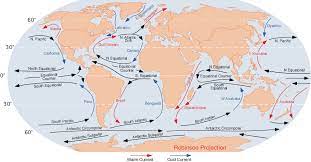Q. What are the forces that influence ocean currents? Describe their role in fishing industry of the world.
Ans: Ocean currents are driven by a combination of forces, including wind, the Earth’s rotation (Coriolis effect), temperature and salinity variations, and gravitational forces. These forces play a crucial role in shaping the patterns of ocean circulation, which, in turn, have significant implications for the fishing industry worldwide.

Forces Influencing Ocean Currents:
- Wind: Wind is one of the primary driving forces of ocean currents. The friction between the atmosphere and the ocean’s surface generates surface currents. Prevailing wind patterns, such as trade winds and westerlies, influence the direction and strength of these currents.
- Coriolis Effect: The Earth’s rotation causes moving air and water masses to be deflected to the right in the Northern Hemisphere and to the left in the Southern Hemisphere. This Coriolis effect plays a vital role in determining the direction of ocean currents.
- Temperature and Salinity Gradients: Differences in water temperature and salinity result in variations in water density. Colder and saltier water is denser and tends to sink, creating vertical movement (upwelling and downwelling) that contributes to the formation of currents.
- Gravitational Forces: Gravitational forces from the moon (tides) and the sun also influence ocean currents. Tidal currents result from the gravitational pull of these celestial bodies and play a role in shaping coastal currents.
Role in the Fishing Industry:
Ocean currents have a profound impact on the fishing industry, influencing fish distribution, productivity, and commercial fishing practices in several ways:
- Fish Movement and Migration: Ocean currents play a key role in transporting plankton, which is the primary food source for many fish species. Fish follow these currents to access abundant food supplies, leading to specific migration patterns and aggregations.
- Upwelling and Nutrient Enrichment: Upwelling, driven by the movement of deep, nutrient-rich waters towards the surface, enhances nutrient availability in coastal areas. This results in higher productivity and supports the growth of phytoplankton, which forms the base of the marine food chain.
- Localized Fishing Grounds: Ocean currents create specific zones with rich fishing grounds due to the concentration of nutrients and prey species. Fishermen often target these areas for higher catch yields.
- Transport of Larvae: Fish larvae are often carried by ocean currents to suitable nursery areas where they can grow and mature. The movement of larvae by currents contributes to the replenishment of fish populations.
- Fishing Strategies: Knowledge of ocean currents helps fishermen optimize their fishing strategies. They can identify areas with productive currents, plan fishing routes, and deploy fishing gear more effectively.
- Challenges and Variability: While ocean currents offer opportunities for increased catch, their variability and unpredictability can pose challenges for the fishing industry. Changes in current patterns due to natural variability or human-induced factors (such as climate change) can impact fish distribution and fishing success.
In summary, ocean currents play a vital role in shaping the distribution, migration, and productivity of marine life, which directly impacts the fishing industry. Understanding the influence of ocean currents is essential for sustainable fisheries management, as it helps fishermen make informed decisions and policymakers develop effective conservation and resource management strategies.